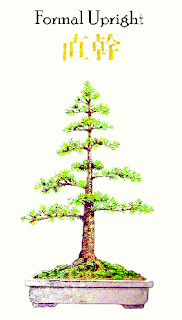 MOYOGI
MOYOGIThis is a variation on the formal upright style but is much easier to create. The rules for the branch structure are the same but the trunk may have any number of curves, both from left to right and from front to back. The branches should ideally grow from the outside of the curvesand never on the inside as this creates a shock to the eye. The apex should lean towards the front.
The tree illustrated is just one of the many variations on the informal upright style. Unlike the Formal Upright, Moyogi works equally as well with deciduous and coniferous species.
CHOKKAN
As the name implies, this is the most formalised of all styles. The trunk must be ramrod straight and bolt upright, tapering uniformly from base to tip. The branches should be arranged alternately either side of the trunk with every third branch to the rear.
The branches should diminish in thickness and in length from the lowest one upwards, and should be either horizontal or sloping downwards. Ideally, the spaces between the branches should also diminish toward the top of the tree, in proportion to their thickness and length.
SHAKAN
Another variation on the formal upright style, except that it is not upright. The trunk is usually straight-ish, although it may have a gentle curve or two. The placement of the branches needs to be carefully thought out in order to stabilise the design and to prevent the tree looking as if it is about to fall over.
Unlike the previous two styles, the number and placement of the branches is less crucial, providing the opportunity for creativity. For instance, using only the top branches and training them down steeply can result in a dramatic image.

FUKINAGASHI
Although this is one of the more naturalistic styles, it is also one of the most dramatic. The aim is to capture the dynamic shape and movement of a tree living high in the mountains or on a clifftop, where it is constantly exposed to high prevailing winds.
There are no rules governing the trunk shape or location of branches, but in spite of this freedom this is one of the most difficult styles to create successfully. The difficulty lies in making the image appear authentic, rather than merely looking like a tree with branches on one side.
The trick is to ensure that the windswept effect begins at the base of the trunk and is re ected in every aspect of the tree.

HAN-KENGAI
Both this style and the cascade style depict trees clinging to a cliff face, where they are beaten by snow, wind and rockfalls. The trunk should have dramatic curves and taper, and the branches should ideally also cascade from the trunk. Tradition states that the inverted ‘apex’ should be positioned directly below the base of the trunk when the tree is viewed from the ‘front’, but this can inhibit the design somewhat.
These days it’s perfectly acceptable to allow the lowest point of the tree to be placed to one side of the pot, as if it was reaching out from a cliff face to find light. The one unbreakable rule is that the lowest point must be below the rim of the pot, but not its base.


0 commenti :
Post a Comment